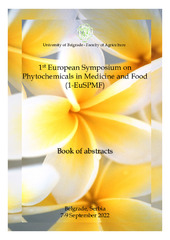Приказ основних података о документу
Microencapsulation of anthocyanins from blue maize and their fate during in vitro gastrointestinal digestion
| dc.creator | Žilić, Slađana | |
| dc.creator | Nikolić, Valentina | |
| dc.creator | Ćujić Nikolić, Nada | |
| dc.creator | Simić, Marijana | |
| dc.creator | Šavikin, Katarina | |
| dc.creator | Živković, Jelena | |
| dc.creator | Vasić, Marko G. | |
| dc.date.accessioned | 2023-12-26T12:41:57Z | |
| dc.date.available | 2023-12-26T12:41:57Z | |
| dc.date.issued | 2022 | |
| dc.identifier.isbn | 978‐86‐7834‐408‐4 | |
| dc.identifier.uri | http://rik.mrizp.rs/handle/123456789/1378 | |
| dc.description.abstract | Although the results provided the evidence of high levels of health beneficial phytochemicals of colored maize [1], it is currently being produced only in small amounts for making specialty foods or for use in ornamentation [2]. The aim of the present research was to develop and examine microencapsulation systems of anthocyanins from waste product of blue maize processing using conventional wall material as maltodextrin (MD), in combination with novel one, hydroxypropyl-β-cyclodextrin (HPCD). Liquid blue maize extract was spray dried with and without adding carrier agents: MD (30%), HPCD (30 %) and combination of both carriers (15% MD and 15% HPCD). The obtained samples were analyzed for the powder property parameters, for the content of phenolic compounds, antioxidant capacity and for the fate of anthocyanins (ACNs) in the digestive system. The content of total free phenolic compounds in microencapsulates was 31380 mg CE/kg on average. A smaller percentage consists of phenolic acids. Seven of them were detected. The ACNs content in the starting raw material was 1426 mg CGE/kg with acylated Cy-3-(6'-Mal-Glu) than Cy-3-Glu as dominant. In microencapsulates the content was 10677 mg CGE/kg on average with a variation of about 4%. Digestion fluids of microencapsulates with 30% of HPCD after each in vitro phase had the highest residue of ACNs (54-69%). On the other hand, the microencapsulation system with 15% MD and 15% HPCD showed the lowest stability. Therefore, the digestibility of these microencapsulates was the highest and amounted to 73.63%. Considering the results, it can be concluded that waste product of blue maize processing in form of microencapsulates can be used in the food and pharmaceutical industry and can also contribute significantly to the daily intake of ACNs, especially acylated forms whose daily intake has been estimated at 23% compared to 77% of non-acylated ones [3]. | sr |
| dc.language.iso | en | sr |
| dc.publisher | Beograd : Univerzitet u Beogradu, Poljoprivredni fakultet | sr |
| dc.relation | ZP projekat info:eu-repo/grantAgreement/MESTD/inst-2020/200040/RS// | sr |
| dc.rights | openAccess | sr |
| dc.rights.uri | https://creativecommons.org/licenses/by/4.0/ | |
| dc.source | 1. european symposium on phytochemicals in medicine and food (1-EuSPMF), Belgrade, 7-9.09.2022. - Book of abstracts | sr |
| dc.subject | microencapsulation | sr |
| dc.subject | blue maize | sr |
| dc.subject | anthocyanins | sr |
| dc.subject | in vitro digestion | sr |
| dc.title | Microencapsulation of anthocyanins from blue maize and their fate during in vitro gastrointestinal digestion | sr |
| dc.type | conferenceObject | sr |
| dc.rights.license | BY | sr |
| dc.citation.spage | 43 | |
| dc.identifier.fulltext | http://rik.mrizp.rs/bitstream/id/6890/bitstream_6890.pdf | |
| dc.identifier.rcub | https://hdl.handle.net/21.15107/rcub_rik_1378 | |
| dc.type.version | publishedVersion | sr |


